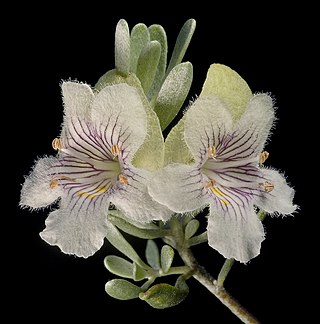
Prostanthera, commonly known as mintbush or mint bush, is a genus of about 100 species of flowering plants in the mint family Lamiaceae, and all are endemic to Australia. Plants are usually shrubs, rarely trees with leaves in opposite pairs. The flowers are arranged in panicles in the leaf axils or on the ends of branchlets. The sepals are joined at the base with two lobes. The petals are usually blue to purple or white, joined in a tube with two "lips", the lower lip with three lobes and the upper lip with two lobes or notched.

Prostanthera incisa, commonly known as cut-leaf mint-bush or native thyme, is a species of flowering plant in the family Lamiaceae and is endemic to south-eastern continental Australia. It is an erect, strongly aromatic, openly branched shrub with hairy, densely glandular branches, egg-shaped to oblong leaves, and pale mauve to mauve flowers.

Prostanthera rotundifolia, commonly known as round-leaved mintbush or round-leaf mint-bush is a species of flowering plant in the mint family Lamiaceae, and is endemic to south-eastern Australia. It is an erect shrub with aromatic branches covered with short hairs and glands, egg-shaped to more or less round leaves and purple to mauve or pinkish flowers on the ends of branchlets.
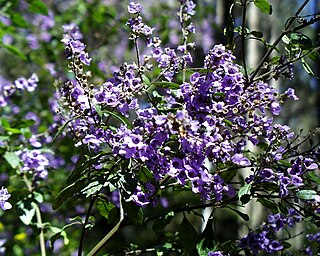
Prostanthera melissifolia, commonly known as balm mint bush, is a species of flowering plant in the family Lamiaceae and is endemic to south-eastern Australia. It is an erect shrub with hairy branches, egg-shaped leaves with fine teeth on the edges and mauve to purple or pink flowers on the ends of branchlets.

Prostanthera cryptandroides is a species of flowering plant in the family Lamiaceae and is endemic to eastern Australia. It is a low, spreading shrub with narrow egg-shaped leaves and lilac to mauve flowers arranged singly in leaf axils.

Prostanthera linearis, commonly known as narrow-leaved mint-bush is a species of flowering plant in the family Lamiaceae and is endemic to eastern Australia. It is an erect, faintly aromatic shrub with glabrous, narrow egg-shaped to linear leaves and white flowers that are often tinged with pinkish-mauve.
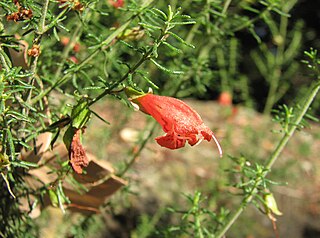
Prostanthera aspalathoides, commonly known as scarlet mint-bush, is a species of flowering plant that is endemic to south-eastern Australia. It is a small shrub with hairy branches, cylindrical or linear to elliptic or oblong leaves and red, pinkish red, or orange flowers arranged singly in leaf axils.

Prostanthera walteri, commonly known as blotchy mint-bush, is a species of flowering plant that is endemic to south-eastern Australia. It is a sprawling shrub with tangled, hairy branches, egg-shaped leaves and usually bluish green flowers with prominent purple veins arranged singly in leaf axils.
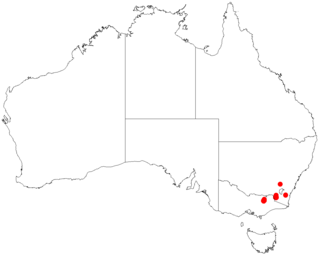
Prostanthera monticola, commonly known as Buffalo mint-bush, is a species of flowering plant in the family Lamiaceae and is endemic to higher areas of south-eastern Australia. It is a sprawling, open shrub with red, hairy branches, lance-shaped to narrow elliptic leaves and pale bluish-green to grey-green flowers with dark purple-blue veins.

Prostanthera rhombea, commonly known as sparkling mint-bush, is a plant in the family Lamiaceae and is endemic to disjunct areas of south-eastern Australia. It is an openly-branched shrub with strongly aromatic branches, circular to heart-shaped leaves and mauve or bluish flowers.
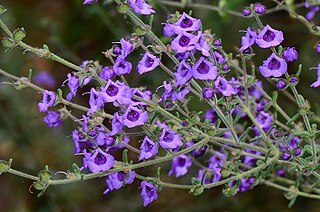
Prostanthera hirtula, commonly known as hairy mintbush, is a species of flowering plant in the family Lamiaceae and is endemic to the south-eastern continental Australia. It is a strongly aromatic, densely hairy, spreading shrub with narrow egg-shaped leaves and dark mauve flowers, and that grows in exposed, rocky sites.
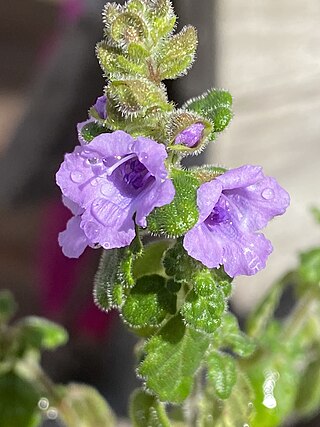
Prostanthera incana, commonly known as velvet mint-bush, is a species of flowering plant in the family Lamiaceae and is endemic to south-eastern continental Australia. It is an erect, moderately dense shrub with egg-shaped leaves, and lilac-coloured flowers, found mostly in near-coastal southern New South Wales.

Prostanthera saxicola is a species of flowering plant in the family Lamiaceae and is endemic to eastern Australia. It is a shrub with linear to elliptic leaves and white to mauve flowers arranged in leaf axils.

Prostanthera serpyllifolia, commonly known as small-leaved mint-bush, is a species of flowering plant in the family Lamiaceae and is endemic to southern Australia. It is a small shrub with small egg-shaped leaves and bright pink to red or metallic bluish-green flowers.

Prostanthera baxteri is a species of flowering plant in the family Lamiaceae and is endemic to the south-east of Western Australia. It is an erect shrub with narrow egg-shaped to linear leaves and white flowers with a tinge of blue to pale mauve.

Prostanthera caerulea, commonly known as lilac mint bush, is a species of flowering plant that is endemic to eastern Australia. It is an erect shrub with narrow egg-shaped leaves that have toothed edges, and white to bluish mauve flowers arranged on the ends of branchlets.

Prostanthera cineolifera, commonly known as the Singleton mint bush, is a species of flowering plant in the family Lamiaceae and is endemic to eastern New South Wales. It is an erect shrub with hairy branches, narrow egg-shaped leaves and clusters of pale mauve to dark purple-mauve flowers arranged on the ends of branchlets.

Prostanthera granitica, commonly known as the granite mintbush, is a species of flowering plant in the family Lamiaceae and is endemic to eastern Australia. It is a spreading shrub with egg-shaped leaves with the edges rolled under, and purple to violet flowers.

Prostanthera ringens, commonly known as gaping mint-bush, is a species of flowering plant in the family Lamiaceae and is endemic to eastern Australia. It is a bushy shrub with four-sided, hairy, densely glandular branches, oblong or egg-shaped leaves and pale blue to greenish or yellow flowers arranged singly in leaf axils.
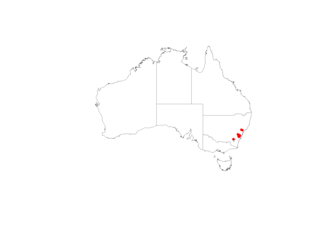
Prostanthera rugosa is a species of flowering plant in the family Lamiaceae and is endemic to a restricted area of New South Wales. It is an openly-branched shrub with egg-shaped or narrow egg-shaped, thick, fleshy leaves and mauve flowers with a white tinge arranged in leaf axils near the ends of branchlets.























